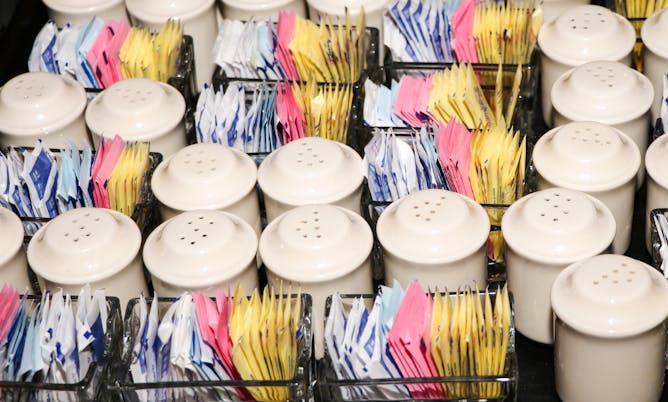|
Doughnuts, candy canes, bananas, soda and even milk – in its own way – all taste sweet. But each is loaded with a different type of sweetener, from glucose, the simplest of sugars, to the industrially manufactured sucralose that goes into Splenda.
But what are all these sweeteners? And how do they work?
Kristine Nolin is a chemist at the Rochester Institute of Technology who loves the science of food. As a starting point for The Conversation U.S.’s new series on sugar, Nolin describes the chemistry of various natural and artificial sweeteners and how the flavors we enjoy are the result of a dance between their molecules and our own taste buds.
The team at The Conversation thought that now – with bellies stuffed with calories from sweet holiday treats and heads pondering New Year’s resolutions about burning them away – would be a great time for a series of stories on sugar. Other articles in the series will explore why evolution gave humans such a sweet tooth, the impact of overconsumption on health and the link between sugar production and race.
Stay tuned over the coming weeks as we follow the not-always-sweet story of sugar.
Also today:
|

Sugar is just one of many flavor enhancers people and companies use to sweeten foods and beverages.
Marie LaFauci/Moment via Getty Images
Kristine Nolin, University of Richmond
Just because something is sweet doesn’t necessarily mean it is sugary. There are a number of molecules that taste sweet. To understand how and why takes a little bit of chemistry.
|
Environment + Energy
|
-
Gale Sinatra, University of Southern California; Barbara K. Hofer, Middlebury
Just because something isn’t 100% certain doesn’t mean you ignore it, and other lessons from two researchers who study the problem of science denial.
|
|
Economy + Business
|
-
David Maimon, Georgia State University
A cybersecurity research group has been tracking a significant rise in the number of stolen checks being sold on sites like WhatsApp and Telegram, which often results in stolen identities.
-
Muhammad Ali Nasir, University of Huddersfield
Will we now see a proper pandemic recovery?
|
|
Science + Technology
|
-
Ivan Anishchenko, University of Washington
Using a form of artificial intelligence called deep neural networks, researchers can generate new proteins from scratch without having to consult nature.
-
Allison Anna Tait, University of Richmond
Online tools promise to democratize estate planning and will preparation, but users are responsible for complying with state laws.
|
|
Politics + Society
|
-
Michael A. Allen, Boise State University; Carla Martinez Machain, Kansas State University; Michael E. Flynn, Kansas State University
If the United States expects to sustain its global influence, it will have to navigate increasing international and domestic pressure against its foreign military presence.
|
|